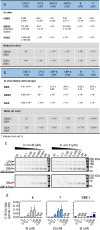Functionalized Cyclophellitols Are Selective Glucocerebrosidase Inhibitors and Induce a Bona Fide Neuropathic Gaucher Model in Zebrafish
- PMID: 30811188
- PMCID: PMC6418866
- DOI: 10.1021/jacs.9b00056
Functionalized Cyclophellitols Are Selective Glucocerebrosidase Inhibitors and Induce a Bona Fide Neuropathic Gaucher Model in Zebrafish
Abstract
Gaucher disease is caused by inherited deficiency in glucocerebrosidase (GBA, a retaining β-glucosidase), and deficiency in GBA constitutes the largest known genetic risk factor for Parkinson's disease. In the past, animal models of Gaucher disease have been generated by treatment with the mechanism-based GBA inhibitors, conduritol B epoxide (CBE), and cyclophellitol. Both compounds, however, also target other retaining glycosidases, rendering generation and interpretation of such chemical knockout models complicated. Here we demonstrate that cyclophellitol derivatives carrying a bulky hydrophobic substituent at C8 are potent and selective GBA inhibitors and that an unambiguous Gaucher animal model can be readily generated by treatment of zebrafish with these.
Conflict of interest statement
The authors declare no competing financial interest.
Figures




References
-
- Tsuang D.; Leverenz J. B.; Lopez O. L.; Hamilton R. L.; Bennett D. A.; Schneider J. A.; Buchman A. S.; Larson E. B.; Crane P. K.; Kaye J. A.; Kramer P.; Woltjer R.; Kukull W.; Nelson P. T.; Jicha G. A.; Neltner J. H.; Galasko D.; Masliah E.; Trojanowski J. Q.; Schellenberg G. D.; Yearout D.; Huston H.; Fritts-Penniman A.; Mata I. F.; Wan J. Y.; Edwards K. L.; Montine T. J.; Zabetian C. P. GBA Mutations Increase Risk for Lewy Body Disease with and without Alzheimer Disease Pathology. Neurology 2012, 79 (19), 1944–1950. 10.1212/WNL.0b013e3182735e9a. - DOI - PMC - PubMed
-
- Sidransky E.; Nalls M. A.; Aasly J. O.; Aharon-Peretz J.; Annesi G.; Barbosa E. R.; Bar-Shira A.; Berg D.; Bras J.; Brice A.; Chen C.-M.; Clark L. N.; Condroyer C.; De Marco E. V.; Dürr A.; Eblan M. J.; Fahn S.; Farrer M. J.; Fung H.-C.; Gan-Or Z.; Gasser T.; Gershoni-Baruch R.; Giladi N.; Griffith A.; Gurevich T.; Januario C.; Kropp P.; Lang A. E.; Lee-Chen G.-J.; Lesage S.; Marder K.; Mata I. F.; Mirelman A.; Mitsui J.; Mizuta I.; Nicoletti G.; Oliveira C.; Ottman R.; Orr-Urtreger A.; Pereira L. V.; Quattrone A.; Rogaeva E.; Rolfs A.; Rosenbaum H.; Rozenberg R.; Samii A.; Samaddar T.; Schulte C.; Sharma M.; Singleton A.; Spitz M.; Tan E.-K.; Tayebi N.; Toda T.; Troiano A. R.; Tsuji S.; Wittstock M.; Wolfsberg T. G.; Wu Y.-R.; Zabetian C. P.; Zhao Y.; Ziegler S. G. Multicenter Analysis of Glucocerebrosidase Mutations in Parkinson’s Disease. N. Engl. J. Med. 2009, 361 (17), 1651–1661. 10.1056/NEJMoa0901281. - DOI - PMC - PubMed
Publication types
MeSH terms
Substances
Grants and funding
LinkOut - more resources
Full Text Sources
Medical
Molecular Biology Databases
Miscellaneous

